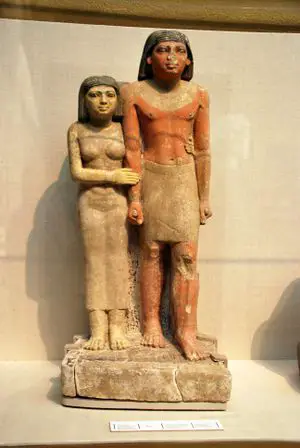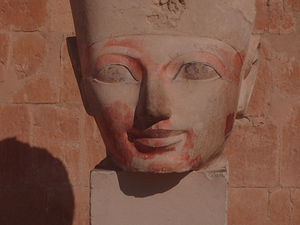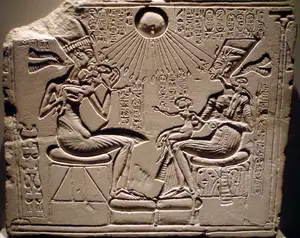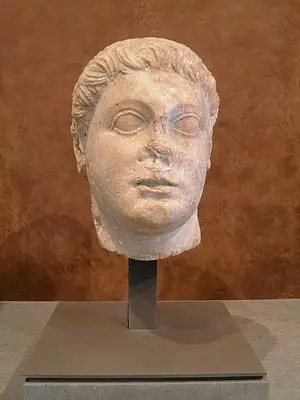Difference between revisions of "How Was Marriage in Ancient Egypt Different than the Modern Concept"
(Created page with "300px|thumbnail|left|Statue of a Non-Royal Married Couple from the Fifth Dynasty A cursory glance at ancient Egyptian art s...") |
(No difference)
|
Revision as of 01:50, 2 February 2018
A cursory glance at ancient Egyptian art shows that they valued the idea of marriage. Couples are depicted together in tombs and among the most popular items found in tombs by modern archaeologists were pair statues, which were meant to portray the tomb owner and his wife. Modern scholars know that the Egyptians practiced a form of marriage, but was it like the modern concept? Much like modern marriage, ancient Egyptian couples lived together, formed households, and were eventually buried next to each other. The idea of couples was an important part of Egyptian society and closely interwoven with their theological ideas: life began with a divine couple and in the afterlife, they believed it was important to have a partner. In those ways, ancient Egyptian marriage was not much different than the modern concept as it was a compact between a couple with strong religious overtones. With that said, the ancient Egyptian concept of marriage differed widely in some ways than the modern view. There was no known marriage ceremony in ancient Egypt and as much as Egypt was a fairly homogenous society, marriage practices were different for non-nobles than it was for the nobility.
Contents
Marriage among Non-Nobles
Perhaps the biggest difference between the ancient Egyptian concept of marriage, among both the nobles and non-nobles, and the modern idea, is there was no marriage ceremony in ancient Egypt. There is no known Egyptian language text that describes a wedding ceremony and in fact there is no single ancient Egyptian word that is the equivalent of marriage. [1] But unlike today, where unmarried couples regularly live together, cohabitation between a man and wife appeared to equal marriage, which is seen in Egyptian texts where the phrase, “to establish a household” seems to be the closest one gets in their language to the word “marriage.” [2]
The reasons for marriage in ancient Egypt were for the most part different than what is practiced in modern industrialized countries, but not unlike what is seen in many places in the Third World. Marriages were part of arrangements meant to bring families together. Although brother-sister marriages were generally unheard of by non-noble Egyptians, marriages between cousins could be a way to bring different branches of a larger family closer. Essentially, marriage was an economic endeavor that could potentially bring more wealth into a family, but always had the potential to create new laborers in the form of children. Especially among the vast majority of Egyptians who were peasants, more children, either through adoption or birth, helped a family be more productive. [3] A short New Kingdom era text from the village of Deir el-Medina demonstrates how much the Egyptians valued the concept of family. In the text, a tomb worker is even given paternity to spend time with his wife and newborn child: “Those who were (with) the chief workman Paneb: Kasa, his wife being in childbirth and he had three days off.” [4]
Marriage may have been a practical and economic venture for most Egyptians, but it was, like most aspects of Egyptian culture, deeply rooted in religion. As stated earlier, the idea of divine pairs played a big role in Egyptian religion and every good Egyptian did his or her best to replicate the behavior of their gods and goddesses. The Egyptians also believed that once someone had died, if he or she lived a good life and did the proper rituals, then he or she would enter the afterlife. Essentially, the Egyptians believed that the afterlife was a duplicate of this life, so in order to enjoy the afterlife to the fullest one would have to have a large family in this life. [5] Despite the solid theological foundations that ancient Egyptian marriage was based on, there were still problems in paradise from time to time.
Marriage Problems in Ancient Egypt
Although the evidence shows that the ancient Egyptians viewed marriage as a lifelong journey, and into the afterlife for that matter, there are texts that indicate not all marriages were happy. A number of texts dated from the New Kingdom (ca. 1539-1075 BC) and the Late Period (728 BC until the Christian Era) demonstrate that Egyptians were aware of potential pitfalls in marriage and took appropriate steps to mitigate problems. If a marriage was dissolved, the husband and wife each had claim to any property acquired in common, although the division of assets was not equal. The man would usually get two-thirds of the property with the woman receiving the remaining third. [6] A New Kingdom text from the workmen’s village at Deir el-Medina shows that some perspective husbands were even willing to sign a type of pre-nuptial agreement, which was apparently drafted by the brides’ family in order to avoid “divorce.” The text reads:
“As Amen endures, as the ruler endures, if I go back on my word and abandon the daughter of Tener-Monthu in the future, I will receive 100 blows and be deprived of all the property that I will acquire with her.” [7]
The above text is rare, but indicates that Egyptians in the New Kingdom were cognizant that not all marriages would work. Like with marriage, the Egyptians had no equivalent word for “divorce,” but their legal system did recognize the end of marriages and the wife’s right to some of the family’s property. Beginning in the seventh century BC, a number of texts were written in the demotic script of the Egyptian language that modern scholars refer to as “marriage contracts.” The contracts, most of which were written long after the couples had been married, are economic in nature, outlining what the wife is entitled to if her husband “repudiates” her. In most contracts, the wife is entitled to one-third of the couple’s property, as mentioned above. [8] The family was truly at the core of Egyptian non-noble society, but evidence shows that not all Egyptians followed the traditional route of marrying young and raising a family.
Dating and Sex in Ancient Egypt
Among the vast majority of Egyptians, marriages were arranged for economic and social reasons, but there is evidence that some Egyptians eschewed their familial help to find them a spouse and instead struck out on their own. This is not to say that there was a “dating” scene in ancient Egypt that was anything like what exists today, but there are a number of extant “love charms” that indicate some Egyptians preferred to choose their own mates. Most of the preserved love charms are dated to the Ptolemaic Period (332-30 BC), but one from the New Kingdom shows that some Egyptians loved the pursuit as much as some people do today. The follow text invoked the power of Hathor, the Egyptian goddess of love:
“Come, (make) [female name] born of [name] come after me like a cow after fodder; like a servant after her children; like a herdsman (after) his herd. If they do not cause her to come after me, I will set (fire to) Busiris and burn up (Osiris). [9]
The text never explicitly states if the man wanted the particular woman as his wife, or if he desired her for purely carnal reasons. After all, the ancient Egyptians, like all people, were subject to many of the same impulses that could lead to affairs, which would not be a good situation if discovered. For those cases, as well as married couples who wanted to manage the size of their families, there were birth control options. A number of extant medical papyri from the New Kingdom demonstrates that the Egyptians had a various of prescriptions for birth control, although their efficacy is doubtful. One prescription called for the placement of lint at the mouth of the uterus before intercourse, while others called for a vaginal infusion of honey and perhaps most bizarre was the use of crocodile dung. [10] As Nunn notes, some of the prescriptions, namely the crocodile dung, may have been intended to repel the man!
Marriage among the Egyptian Royals
The theological reasons for royal marriage was much the same as it was for the non-royals and the process by which couples were matched was also similar. Marriage arrangements were done to keep wealth in a family, or bring more to it, and most importantly royal marriages were a way to cement political alliances. There is a common misconception that the ancient Egyptians were ardent practitioners of consanguineous marriage and that incestuous sex in general was quite common, but the evidence shows that is was almost unheard of among commoners and relatively rare among the nobility, with it happening the most during the Eighteenth and Nineteenth Dynasties of the New Kingdom (ca. 1539-1306 BC). [11] The best known case of royal incest in the New Kingdom was the marriage of Hatshepsut (ruled ca. 1490-1469 BC) to her half-brother Thutmose II (reigned ca. 1494-1490 BC). The two probably never met each other until their marriage and during that time Hatshepsut served as one of the king’s minor queens until his death when she then assumed the masculine title of king, nesu, of Egypt. The example also shows that polygamy was common among the royals, although it was relatively rare among non-royal Egyptians. The reason for the public perception of consanguineous marriage being common in ancient Egypt probably stems from the Ptolemaic Period.
When the Greek Ptolemies ruled over Egypt, they attempted to do so as legitimate Egyptian kings and queens by adapting the customs and culture, at least outwardly, of the Egyptians. In their quest to appear as legitimate Egyptians, though, the Ptolemies misinterpreted some elements of pharaonic culture. Most of the Ptolemies, with the exception of some of the later rulers, never bothered to learn the Egyptian language and therefore probably misunderstood the nature of Egyptian texts that were read to them. For instance, in many pharaonic texts, married couples often referred to each other as “brother” and “sister,” which apparently led them to believe that incestuous marriage was a common Egyptian practice. [12] Ptolemy II (ruled 284-246 BC) took this misinterpretation of Egyptian language and used it to institutionalize consanguineous marriage by marrying his full sister Arsinoe. Most of Ptolemy II’s successors followed suit as seven of the thirteen later Ptolemies contracted such marriages. [13]
Conclusion
Marriage in ancient Egypt was certainly very different than it is today in the modern world, especially in industrialized nations, but there were some similarities as well. Although there was no official marriage ceremony, young Egyptians of all classes were expected to marry in order to strengthen their families and to provide assistance and companionship in the afterlife. The Egyptian royals married for many of the same reasons, but when the Greek Ptolemies ruled the Nile Valley they institutionalized the practice of incestuous marriage, which today many wrongfully associate with all of ancient Egypt.
References
- ↑ McDowell, A. G. Village Life in Ancient Egypt: Laundry Lists and Love Songs. (Oxford: Oxford University Press, 2001), p. 32
- ↑ Robins, Gay. Women in Ancient Egypt. (Cambridge: Cambridge University Press, 1993), p. 56
- ↑ Robins, p. 59
- ↑ McDowel, p. 35
- ↑ Robins, p. 72
- ↑ McDowell, p. 32
- ↑ McDowell, p. 33
- ↑ Robins, p. 60
- ↑ McDowell, p. 33
- ↑ Nunn, John F. Ancient Egyptian Medicine. (Norman, Oklahoma: University of Oklahoma Press, 1996), p. 196
- ↑ Middleton, Russell. “Brother-Sister and Father-Daughter Marriage in Ancient Egypt.” American Sociological Review. 27 (1962) p. 604
- ↑ Manniche, Lise. Sexual Life in Ancient Egypt. (London: Keegan and Paul, 1987), p. 29
- ↑ Middleton, p. 606



